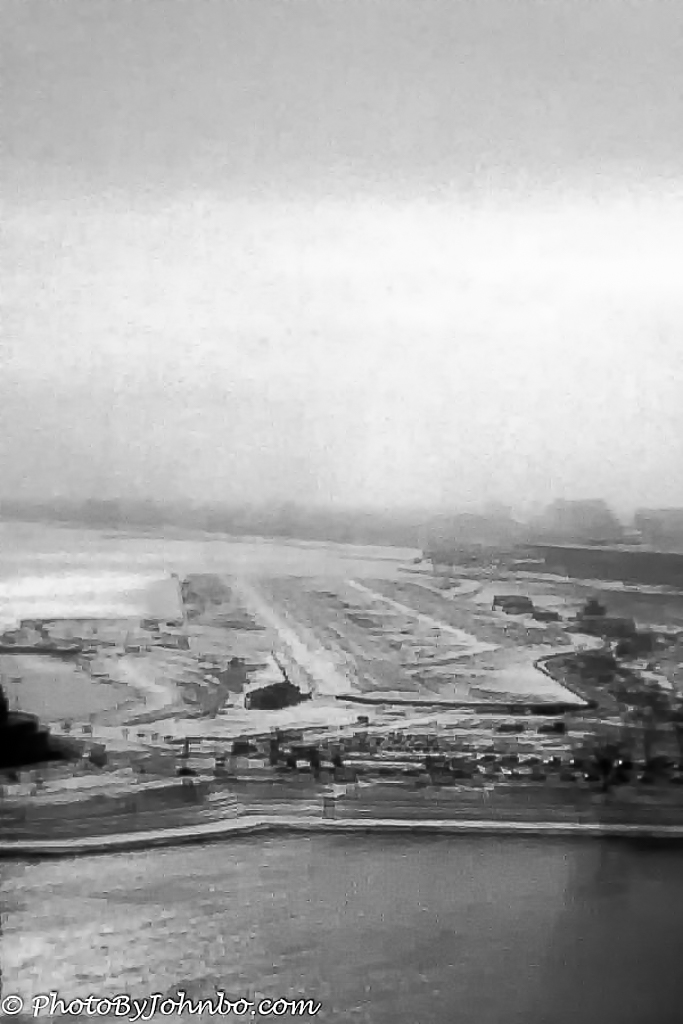Chicago, Illinois.
I don’t often post a Monochrome Monday image, but who knows… it’s a new year, maybe I’ll do this more often. In any case, my first submission this year is a noisy, fuzzy image from a consumer grade digital camera captured in either late 2002 or early 2003. I could find the exact date as the flight is in my pilot’s log books, however they are in Fargo and I am in Buckeye for the winter. No metadata is available in the image which was captured just prior to turning toward final approach at Meigs.
There is a story behind this photo that I rediscovered as I upgraded my backup hard drive to allow me to store more images. Let me begin…
Once upon a time…, no… Call me Johnbo…, no…, It was a bright cold day in April, and the clocks were striking thirteen…, no…, It was a dark and stormy night… no.
Let’s start at the beginning. I virtually visited Meigs Field probably hundreds of times, but I only landed and took off from there for real once. And then Meigs Field was no more. One of the driving forces that eventually led me to seeking out a pilot’s license is my love of computers and all things technological. At one point, I discovered Microsoft Flight Simulator and from it, I learned much about aviation. Some would say it taught them to fly, but I question that, especially in those early versions. With today’s simulators, true flight instruction is possible, but in my days before starting flight instruction for real, I spent hours in simulated flight all over the world. Many of those flights departed from the Microsoft Flight Simulator default airport, Merrill C. Meigs Field, built on a man-made peninsula on Lake Michigan in Chicago.
Meigs Field opened in 1948 and served private aircraft travelling to Chicago until 2003 when it was summarily closed by Mayor Richard M Daley. For those interested in the story of the closing, a Google search of Meigs Field will bring up many posts about the questionable nature in which the airport ceased service, stranding 16 aircraft on the ramp when the mayor ordered bulldozers to tear up the runway in a midnight raid.
This old photo prompted the memory of the day of our first and last trip into Meigs Field for real. It was cold, there was some snow and the ground, and the sky over the airport was cloudy. For aviation types, however, the field was reporting marginal VFR. In other words, we were able to fly there visually and did not need to use an instrument approach. I flew there with another pilot friend, Walt. The purpose of our trip was simply to say that we once landed and took off from the iconic airport. It was well known at the time that Mayor Daley wanted to close the airport, and there was lots of controversy about the issue. Walt and I figured that if we were ever to fly into Meigs for real, we better do it soon.
We flew from Fargo to Madison, Wisconsin and spent the night there, with our trip to Chicago’s famous airport scheduled for the next morning. We were hoping for clear weather, but it was not to be. Most of the flight from Madison was clear or with higher level clouds, but the cold water of Lake Michigan left Meigs Field with low clouds along the shoreline.
We didn’t stay long, after parking the aircraft, we went inside and paid the $34 landing fees, took a short break and after a couple more takeoffs and landings so each pilot got the chance to land and takeoff, we departed for our return to Fargo. On March 31, 2003, city crews bulldozed the runway which ended over half a century of service to aviators and businessmen wishing to meet in Chicago. Small planes now must fly into Chicago Midway and take a much longer drive or taxi ride into the downtown area.
About the photo: The metadata for this photo has been lost (if it ever was there). All I remember is that I captured it with one of my first digital cameras, a Fuji. The camera had a low megapixel rating, though I don’t recall any of the specs. I treated it this morning for publication using several Nik Tools in hopes of making it a better photo. I used it as a training tool to help me learn Nik’s noise reduction, image sharpening and monochrome conversion tools.
John Steiner

